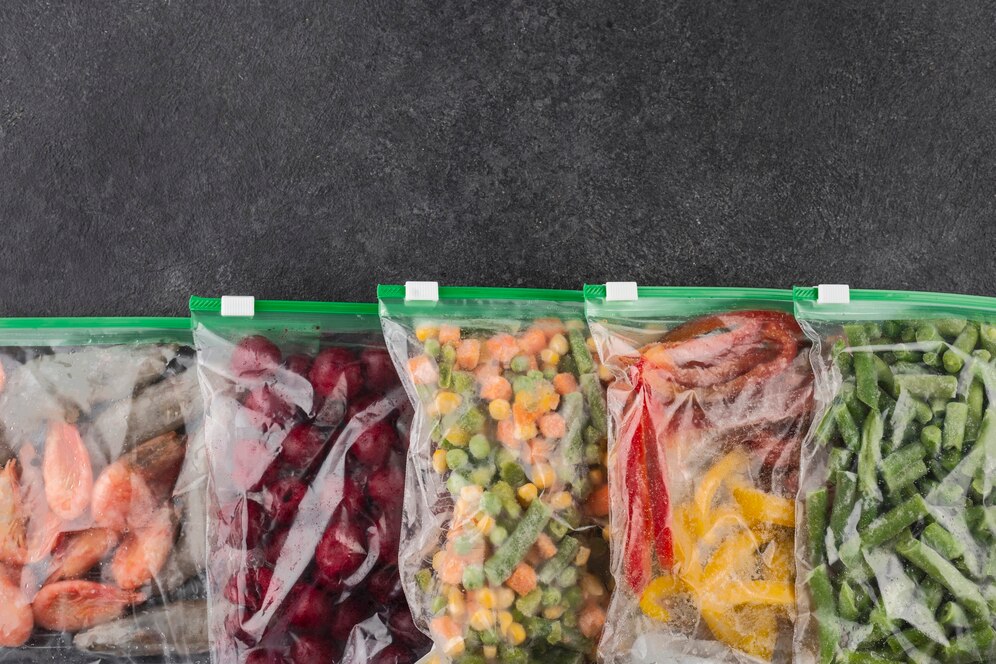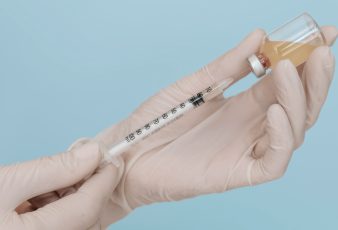Whether you’re a small bakery selling artisan bread or an established national brand shipping palettes of frozen dinners cross-country, safety, and purity should be non-negotiable when your products directly impact what families put on their dinner tables.
We rely on the integrity of the food supply chain not just for great taste but for peace of mind. In an increasingly health and socially conscious consumer environment, transparency about what touches our food before it reaches our homes can make or break customer trust.
Understanding food-grade plastics and properly incorporating food-grade packaging to protect quality from prep to purchase is the key to providing that clarity and safety. This post will show a deep comparison of different materials used in food-grade poly bags and will help you understand what you should choose for your business.
Following FDA And Food Contact Guidelines
Before we dive into comparing particular materials like types of polyethylene and polypropylene, it’s important to level-set on what makes any plastic authorized for direct food contact.
The Food and Drug Administration (FDA) has established strict specifications around chemicals and additives allowed to interface with consumables categorized under 21 CFR resin codes. Any packaging touting food-grade status must pass muster based on these codes dictating extractable contaminants, acceptable levels of radiation used for sterilization purposes, and other safety testing criteria.
FDA Approval Process
The approvals process centers around the FDA’s established guidance on thresholds for potentially harmful chemicals leaching into foodstuffs based on tests mimicking various conditions like heating, freezing, transportation motion, UV exposure, etc. The agency outlines a methodology for food manufacturers to analyze direct, indirect, and intended uses of new food contact materials with emphasis on safety even in extreme scenarios.
Base Polymer Properties
The elemental polymers themselves start this testing gauntlet based on existing risk assessments. Polyethylene (PE), polypropylene (PP), and other common plastics must demonstrate negligible reactivity and migration of harmful substances first at a base resin level.
Manufacturers confirm basic polymer chains durable enough for any further fabrication whether as food packaging liners or flexible delivery bags meet these intrinsic safety standards through FDA submissions. That pure form then becomes eligible for the next level of scrutiny in finalized products.
Food Safe Modifications
Additives like colorants, lubricants for machinery shaping, labels, glues, and other modifications face individual toxicology reviews for changes potentially introduced after initial resin approval. These inputs must also meet food-safe directives per application.
Polyethylene (PE) Food Grade Bags
As the most ubiquitous plastic globally, polyethylene dominates packaging across industries, including extensive usage for food contact purposes. Branded under the recycling code #4, PE food grade bags provide flexibility, stretch, and effective moisture barriers that lend well to many meal prep and grocery applications once meeting purity standards.
The lightweight polymer cuts across two varieties – low-density polyethylene (LDPE) and high-density polyethylene (HDPE) – each with advantageous properties and drawbacks:
LDPE Food Grade Bags
The soft, pliable nature of LDPE enables strong heat seals and optical clarity perfect for food visibility. As a high gloss and low haze option, LDPE allows package printing for branding while preventing oxidation and maintaining integrity for items with water content. Downsides reflect low rigidity and tear resistance along with permeability allowing gases like oxygen and carbon dioxide to escape over time.
Common uses:
- Bread bags
- Frozen food liners
- Squeeze bottles
- Food storage
HDPE Food Grade Bags
For more solid fare and durable delivery, HDPE brings added stiffness, strength and high-temperature tolerance floating its higher relative cost. Impermeable structures prevent moisture loss, lending well to crackers, granola and other crisp goods. Lack of transparency coupled with chemical leaching susceptibility at higher heats restricts some direct cooking applications without inner liners though.
Common uses:
- Milk cartons
- Bleach bottles
- Shampoo and detergents
- Butter tubs
With versatility spanning across LDPE and HDPE varieties factoring in objectives around flexibility, strength, clarity and permeability, polyethylene offers broad applicability at affordable price points for securing safe food conveyance when properly meeting purity regulations.
Polypropylene (PP) Food Grade Bags
Beyond polyethylene, polypropylene (PP) represents another widely adopted plastic for food-grade packaging purposes once properly meets purity standards. Classified under recycling code #5, polypropylene bags offer high melting points, structural rigidity, and chemical inertness aligning well with certain food transportation and storage needs.
As a nonpolar hydrophobic thermoplastic, polypropylene delivers strong chemical and moisture resistance coupled with high dimensional stability across temperature fluctuations. This enables durable performance for hot fill and autoclaving applications for things like ready-to-eat meal trays. Sound insulation properties also reduce abrasion and impacts during transport.
On the downside, polypropylene tends to lack UV resistance and scratch susceptibility can cloud otherwise clear packaging aesthetics over time. The cost and weight also exceed polyethylene equivalents.
Common food-grade applications capitalizing on innate barrier protections and thermal resistance include:
- Microwavable containers
- Disposable cutlery
- Condiment bottles
- Beverage case liners
- Candy and nut containers
For food enterprises like catering, events and processing requiring steadfast containment across ingredients, polypropylene checks off safety and performance boxes as an optimal polymer solution.
Polylactic Acid (PLA) Food Grade Bags
Moving beyond conventional polymers, Polylactic acid (PLA) has emerged as a bioplastic alternative for select food-grade packaging applications emphasizing sustainability. Derived from plant starch sources like corn, potatoes or sugar cane, PLA delivers several advantageous properties around renewability and compostability.
As an odorless, glossy thermoplastic, PLA can match the clarity and processability of more commonplace plastics like PET or PS while breaking down in commercial compost facilities – a key eco-friendly factor food enterprises have taken interest in. The packaging also tends to release fewer greenhouse gasses compared to traditional polymers through renewable inputs.
On the limitations side, PLA hardness and stiffness lag more flexible films of comparable thickness. Permeability also challenges sealing in moisture and gases without Pairing PLA with specialty coatings adds cost not seen in conventional food packaging plastics. There are also questions about carbon footprint balances when factoring in agricultural land impacts.
With an emphasis on sustainability through transparent appearance and biodegrading without endlessly accumulating in landfills, PLA food-grade bags and containers appeal to eco-conscious food suppliers and end consumers alike. Usage tilts towards pre-packaged goods like salad mix pouches and snack bags given seals struggle to contain liquids long term.
Comparison Of Key Characteristics
When evaluating the myriad plastics available for compliant food packaging, several pivotal factors bubble up that industry buyers and consumers alike assess in determining optimal solutions for their needs:
Durability
If withstanding transport shocks and distortion across supply chains before making it safely to kitchens is paramount, high-density polyethylene (HDPE) and polypropylene (PP) deliver the ductility and impact resistance critical for food integrity. More flexible low-density polyethylene (LDPE) and polylactic acid (PLA) bags puncture and tear easier from drops or sharp container edges.
Clarity and Odor Barriers
Here polyethylene reigns supreme if food visibility for positioning, portioning or cooking cues adds value. LDPE enables strong yet pliable transparency without yellowing over time found in other polymers. For an impenetrable odor shield vital to avoiding cross-contamination of easily tainted foods, PP and HDPE keep unwanted smells at bay.
Sustainability Factors
As the environmental impacts of packaging decisions weigh more, PLA food grade bags stand apart through renewable inputs and decomposability tied to commercial composting. Polyethylene and polypropylene remain stubbornly hard to breakdown after use without dedicated recycling. quantifying full sustainability though proves tricky across measures like renewability, recyclability, and overall carbon footprints.
Cost Considerations
Basic economics around supply and production volumes position polyethylene bags and packaging with significant per-unit price advantages. More specialized materials like PLA currently suffer pricing premiums through less-scaled manufacturing. Bulk-order polypropylene trays and containers can still compete on cost with flexibility around order quantities.
Evaluating tradeoffs around performance, presentation, responsible sourcing and expenses provides food enterprises with a broad framework for determining ideal plastic packaging materials for any specific application. Prioritizing key selection criteria allows better alignment to usage needs and target consumer values as well.
Final Word
When it comes to food packaging, plastic materials attract inherent skepticism despite extensive safety testing and purifying processes to earn “food grade” status. But compliance and precaution need not curb innovation as polyethylene, polypropylene, and increasingly sustainable options like PLA responsibly extend food integrity and accessibility.
Rather than hesitate to integrate helpful polymers slow to gain public trust, the opportunity exists to accelerate adoption through education. Savvy food enterprises willing to amplify product safety stories woven less from slick packaging than transparent truths stand to gain consumer confidence along with competitive advantages. In food and business, safety and success need not be opposing forces with openness as the binding ingredient.
Read Also:





























